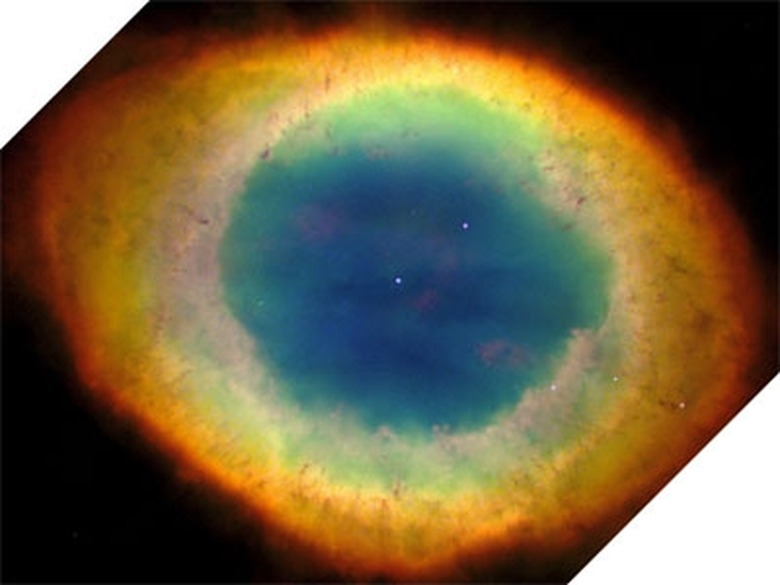How Does The H-R Diagram Explain The Life Cycle Of A Star?
The sun provides a handy benchmark for describing other stars. The mass of this solar system's sun gives us a unit for measuring other stars' masses. Similarly, the sun's luminosity and surface temperature define the center of the Hertzsprung-Russell Diagram (H-R Diagram). Plotting a star on this chart reliably predicts other qualities of the star, such as mass and age.
The X-axis
The X-axis
The X-axis of the H-R Diagram indicates the star's surface temperature in degrees Kelvin. The temperature increases from right to left–backward from most charts you may be used to using. The H-R Diagram uses a ratio scale; each evenly spaced mark represents a temperature twice that of its neighbor to the right.
The X-axis may also be labeled according to spectral class, which varies predictably with its surface temperature. The hottest stars appear white or even blue while the coolest appear red. In between the extremes, you'll find this solar system's sun. Star colors are classified by letter, from bluest/hottest to reddest/coolest: OBAFGKM.
The Y-axis
The Y-axis
The Y-axis indicates luminosity, or brightness. It increases from bottom to top according to a ratio scale. The most common unit of measurement is a luminosity equal to the sun, such that the center label is 1 (one) and labels proceed in both directions by exponents of 10.
The Y-axis may also be labeled in terms of "absolute magnitude." This term refers to the visible light a star would appear to emit if it were 10 parsecs from the earth.
Main Sequence
Main Sequence
The main sequence phase of a star's life cycle is that time during which hydrogen fusion takes place in its core. But in terms of the H-R Diagram, "main sequence" also refers to a roughly diagonal, slightly S-curved line stretching between the upper-left and lower-right corners on which main sequence stars chart. They maintain a predictable relationship between luminosity and temperature: the brighter, the hotter. Both of these traits increase with a star's mass; a star indicated closer to the upper-left corner will be "heavier" than our sun, while lower-right main sequence stars will be "lighter."
Red Giants
Red Giants
Should astronomers plot a newly discovered star in the upper-right corner of the H-R Diagram, being both bright yet cool, they'll immediately know what phase of its life cycle the star is enduring. A red giant's core, hot enough to fuse helium and even heavier elements, has pushed its shell layers so far out that they can cool into the red spectrum. They owe their great luminosity not to their temperature, but to their size: bigger stars radiate more light energy.
White Dwarfs
White Dwarfs
You can be just as certain of the life cycle phase of a star that's both very hot yet very dim. The lower-left quadrant of the H-R Diagram belongs almost exclusively to white dwarfs.
After a red giant of similar mass to our sun burns up all its helium, gravity has free rein to compress its core as far as the carbon electrons therein will permit. This great density creates enormous core heat. And because the core is all that's left at this point, core temperature is surface temperature. Thus, white dwarfs plot to the left on the H-R Diagram. Heat notwithstanding, their small size means less total energy radiated–less luminosity, and a lower position on the diagram.
As it ages, the white dwarf will cool, radiating away all its heat and producing no more. Its position on the H-R Diagram will move downward toward the right until it disappears from view.
Cite This Article
MLA
LeBoeuf-Little, Nicole. "How Does The H-R Diagram Explain The Life Cycle Of A Star?" sciencing.com, https://www.sciencing.com/hr-explain-life-cycle-star-5507250/. 24 April 2017.
APA
LeBoeuf-Little, Nicole. (2017, April 24). How Does The H-R Diagram Explain The Life Cycle Of A Star?. sciencing.com. Retrieved from https://www.sciencing.com/hr-explain-life-cycle-star-5507250/
Chicago
LeBoeuf-Little, Nicole. How Does The H-R Diagram Explain The Life Cycle Of A Star? last modified March 24, 2022. https://www.sciencing.com/hr-explain-life-cycle-star-5507250/
